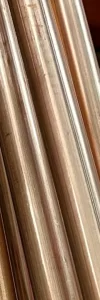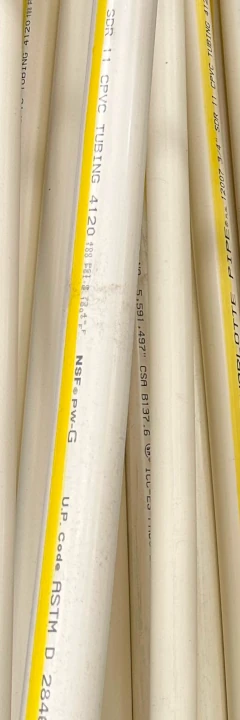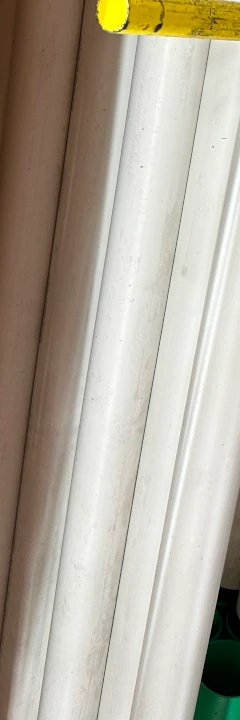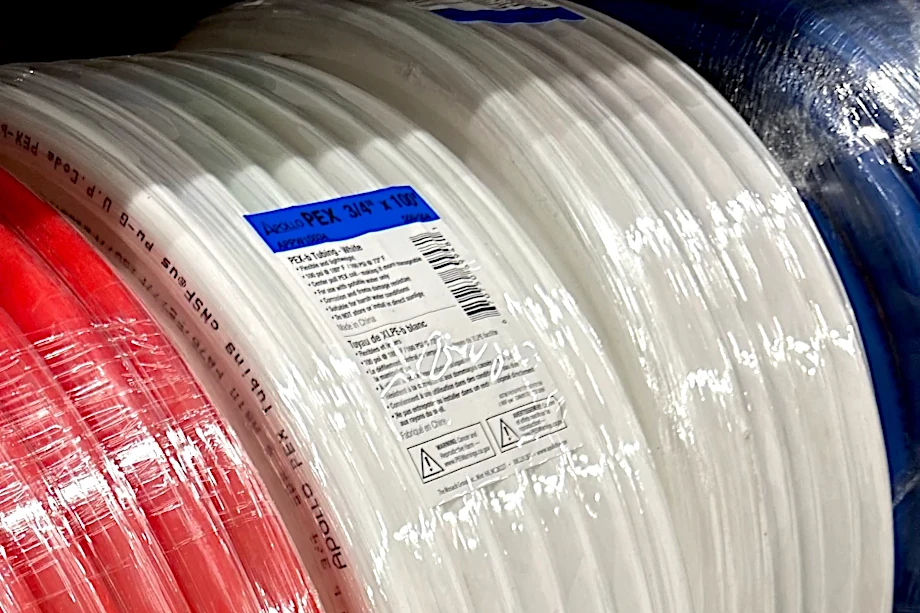In this post, we explain the different types of plumbing pipe frequently found in your home and where they are used. In our bathroom remodeling or kitchen remodeling projects, we end up tying into the existing plumbing in the house.
Plumbing pipes perform two basic functions in your home:
- Supply lines, which are pressurized and distribute potable water from the main water utility service line to your faucets, showers, toilets, and appliances.
- Waste or sewer lines, which carry used water out of the home.
We work primarily on older homes. They were typically built with copper or galvanized steel pipe for the pressurized lines and cast iron for the waste lines.
Types of Plumbing Pipe: Supply Lines
Metal
Metal piping owes its popularity to its longevity and durability. The primary disadvantage of some types of metal piping is that they corrode over time and can flake off rust.
The following metals contain negligible amounts of iron, so iron oxide, or rust, does not form.
Copper

While copper can be used as both supply and waste lines, it is most commonly used in supply lines. There are four major types of copper pipes:
- Type M: The most common, used to carry domestic water. Type M pipe commonly supplies toilets, sinks, and faucets.
- Type L: Thicker and more frequently seen as boiler piping and in commercial fire protection applications.
- Type K: The thickest pipe, and overkill for our home remodeling projects. It can be used for main water lines and underground.
- DWV (drain, waste, and vent): Used for waste, drains, and vents in some midcentury and older homes. When we encounter this type of plumbing during a home remodeling project, we usually replace it with a more modern pipe to save on cost.
Stainless steel
Stainless steel is generally not used in remodeling projects.
But some stainless-steel alloys—a nickel-steel alloy, for example—offer even more corrosion resistance than stainless steel alone.
Other materials—such as molybdenum—strengthen steel, which reduces the amount of material used and yields a lighter-weight finished product.
Brass
Brass is most commonly used between two dissimilar metals to stop a dielectric reaction. An example would be transitioning from old galvanized pipe in the wall to copper stub outs when remodeling a bathroom.
Brass costs less than other metals such as stainless steel or copper. But it can be difficult to work with because of its high melting point. In addition, it’s susceptible to tarnishing over time if exposed to certain elements.
Galvanized

Galvanized steel pipes have been dipped in a protective zinc coating to prevent corrosion and rust. Commonly installed in homes built before 1960, galvanized pipe was an alternative to lead pipe for water supply lines.
Galvanized steel is not often used for water anymore because the galvanizing process is not as good as it used to be, and the pipes do not hold up. We use it only for small repairs of existing galvanized plumbing.
Long-term exposure to water causes galvanized pipes to corrode and rust on the inside.
However, galvanized steel is much more resistant than copper to freeze damage.
Plastic
Plastic pipes are generally lighter, easier to work with, and less expensive to install. They are also easier to cut and fit into tight areas. In addition, it’s generally easier to find odd or unusual plastic pieces.
On the downside, plastics are not as heat resistant and require more frequent replacement than metal piping. Also, use of some plastic pipes is restricted in some municipalities.
PEX

PEX—declared by Family Handyman magazine as the “biggest revolution since the flush toilet”—has been a game changer for us as remodeling contractors.
Short for cross-linked polyethylene, PEX is much cheaper and freeze-resistant than copper pipe. It also installs faster, and Its flexibility can sometimes save us from having to open walls during remodeling.
PEX comes in rolls, 20’ sticks, and 10’ sticks. Because PEX has a “memory”—it tends to return to its original shape—the sticks can be easier to work with in a wall cavity.
The rolls are superior for long runs because there are no joints that could be potential failure points.
PEX pipe is available in three main colors for indoor plumbing: red (for hot water), blue (for cold water), and white. While the chemical structure is the same between the colors, color coding makes it easier to trace a line for repair or make the final connections to a kitchen sink or a shower valve during a bathroom remodeling project.

CPVC
An upgrade from PVC, CPVC (chlorinated polyvinyl chloride) can withstand higher temperatures—up to 200°F—than PVC.
Also, it is more durable than PEX and less susceptible to damage from hazardous materials or extreme heat.
Downsides of CPVC: It is not resistant to UV rays; it has to be glued at every joint (more potential failure points); it can become brittle.
Types of Plumbing Pipe: Waste Lines
If you have an older home, you may see a mix of pipes manufactured from cast iron, plastic, copper and galvanized pipe. Here are the general kinds of waste line piping you can choose from.
PVC

PVC (polyvinyl chloride) is generally the go-to material for waste lines. It’s highly resistant to chemicals, it’s easy to cut, and it resists heat.
Using a chemical solvent and plastic fittings, your plumber can create a lasting seal where cuts need to be made.
Cast iron
Cast iron is a very durable and highly sanitary material for use in the home. The reason to use it: it is quiet; PVC is loud.
The reasons to not use it: it is heavy and expensive, can corrode over time, and is harder to work with. Today, most plumbers use PVC to replace waste line piping.
Chromed brass
Chromed brass is an effective alternative to PVC piping in areas where the pipes are exposed or in municipalities where PVC is not allowed. Its enhanced visual appeal makes it popular for exposed drains.
Types of Plumbing Pipe: Conclusion
As you can see, there are many different options for replacing the plumbing in your home.
If you are still unsure about what plumbing options are right for your kitchen or bathroom remodeling project, feel free to contact us at LaBonte Construction—voted Best of Milwaukee 2022 in the Bathroom Remodeler and Kitchen Remodeler categories by Shepherd Express readers.

